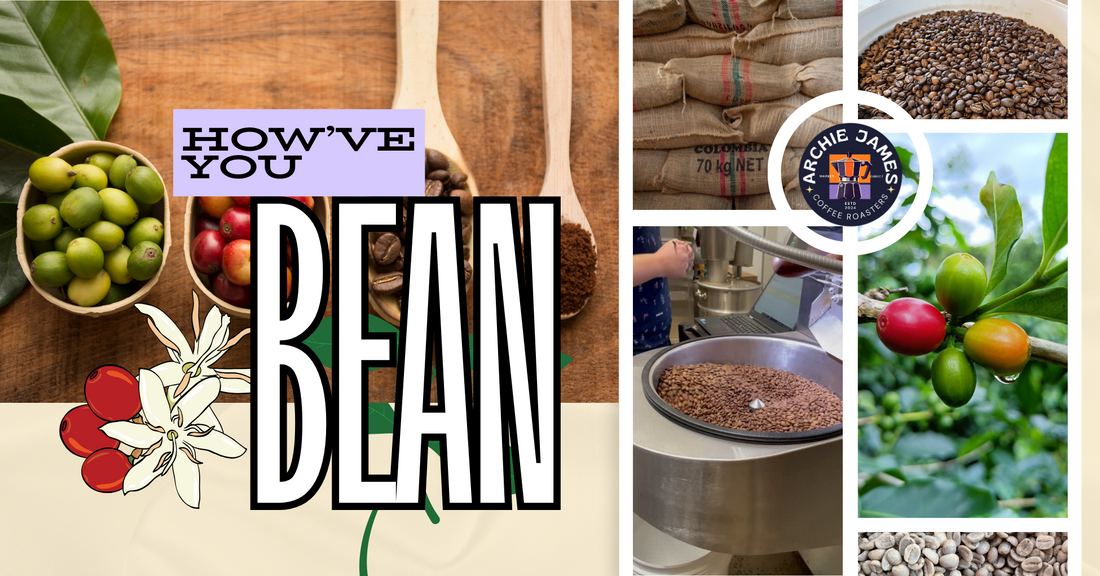Flavours in Coffee
Rhiannon Spencer
Share
Where Do Coffee Flavours Come From?
“How do you guys get the raspberry flavour in the coffee?”
It’s one of our favourite questions. Occasionally, we’ve had market customers take a sip of our El Salvador Finca Los Naranjos (red label) and their perception of what coffee should taste like is challenged. Perhaps their preferences to coffee are usually focused on perceived bitterness or strength and now they are introduced to a bright, fruity coffee with notes of raspberry and red candy. Those flavours weren’t added with syrups or flavourings, it’s just the coffee, as it is. So how is that possible?
It's not weird that coffee has fruity flavours because coffee actually is a fruit, or more specifically, a cherry. Inside each cherry, you'll typically find two small green seeds pressed together, which gives them their characteristic flat side. Occasionally, only one seed develops, resulting in a smaller, rounder (and cuter!) bean known as a peaberry. The term "coffee bean" refers more to the seed's shape than its true botanical nature.
Consider for a moment that both wine and coffee are made from fruit. Most wine drinkers can tell the difference between a crisp sauvignon blanc and a sweet moscato or between an inexpensive table wine and a premium bottle from a renowned region. You don’t need to be a sommelier to enjoy wine, and you don’t need to be a barista to appreciate coffee. With both, simply slowing down and paying attention can reveal subtle flavours that tell a story about the fruit, where it was grown, and how it was processed.
Every step of the coffee journey, from origin to your cup, influences the final flavour. These flavours are already inside the bean (or to be more precise precursor flavour compounds) and it’s up to the producer, roaster, and brewer to bring them to light.
Let’s break it down into three core stages: processing, roasting, and brewing.
1. Processing: Laying the Foundation
Once coffee cherries are harvested, they need to be processed to remove the seeds (what we call beans). How that’s done has a huge impact on flavour. The differences in processing methods are often dependent on the traditions of a particular origin and availability of water; for example Rwandan and Kenyan coffees are often washed (or wet) processed and this can create a clean, bright, and more acidic flavour profile. You might find citrus, floral, or berry notes. Coffees from Ethiopia and Yemen are often processed naturally (or dry), meaning the fruit and skin is still on the bean, which often results in more intense, fruity, or fermented flavours.
What’s wild is that these flavours, like lemon, blueberry, or mango aren’t added. They’re the result of naturally occurring compounds in the coffee that remind you of familiar flavours. So when someone says, “This coffee tastes like raspberry,” they’re picking up on these naturally present notes and what they are reminded of when they taste them.
2. Roasting: Unlocking What’s Inside
Once processed, green coffee beans don’t taste like much. It’s roasting that transforms them.
Roasting coffee is like developing film; you can either reveal the potential flavours clearly or mess it up with overexposure. A skilled roaster knows how to highlight what the bean already has. Light roasts tend to preserve more of the bean’s natural character, such as floral, fruity, complex characteristics. Darker roasts emphasise roast-driven notes such as chocolate, caramel and toasted nuts.
The roast doesn’t create fruit flavours; it unlocks and balances them. If you imagine all the possible flavours of a coffee as a spectrum, roasting decides which ones you’ll actually get to taste.
3. Brewing: Bringing it to Life
This is where you (or your barista) step in.
Even the best beans, perfectly processed and roasted, can taste flat or bitter if brewed incorrectly. Grind size, water temperature and brew time can all affect extraction. Brew it right, and you’ll open a window into the true personality of that coffee. Brew it wrong, and it’s like trying to appreciate a painting through a dirty window. You’ll miss the nuances.
So, where does the raspberry flavour come from? The answer is: from the coffee itself and from the craft at every stage of its journey.
Flavours like berries, citrus, chocolate, or florals aren’t artificial; they’re part of coffee’s natural chemistry. Specialty coffee is about revealing the incredible flavours that are already in the bean.
So next time you take a sip and think, “Whoa, is that pineapple?” you’re not imagining it. You’re just tasting coffee for what it really is.
Curious to try a coffee that surprises you? Check out our rotating range of ethically sourced, expertly curated single origin beans roasted for filter or espresso.
